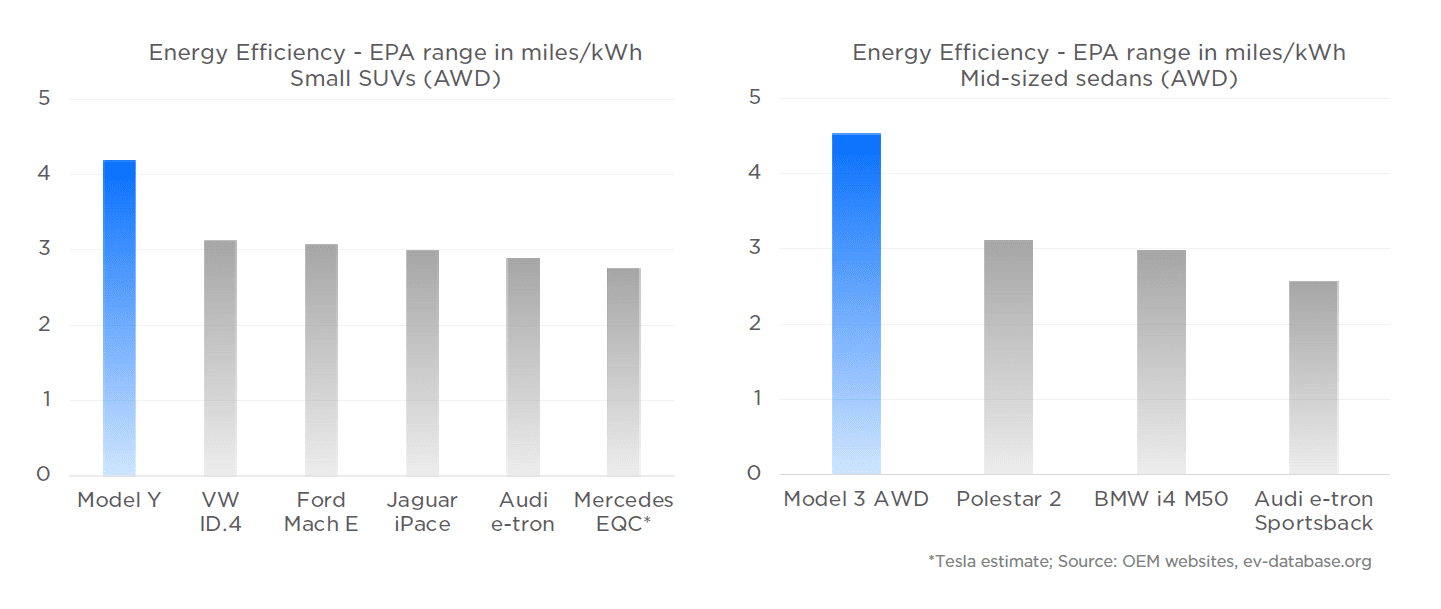Energy efficiency should be a key factor for many people considering a purchase of an electric vehicle. The question is: Which EVs deliver the most range for a single kilowatt hour of energy?
Tesla says its cars are the most efficient, and in its recent Impact Report compares the Model 3 electric sedan and Model Y electric crossover against other EVs.
As per the chart from Tesla’s Impact Report, the Model 3 can travel almost 1.5 miles further than its closest competitor, the Polestar 2, on a kilowatt-hour of energy. Likewise, the Model Y can travel about 1 mile further than its closest competitor, the VW ID.4.

“Tesla vehicles are known to have the highest energy efficiency of any EV built to date,” Tesla claims in its report.
“In the early days of Model S production, we were able to achieve energy efficiency of 3.1 EPA miles/kWh. Today, our most efficient Model 3 Standard Range Plus (SR+) achieves an EPA range of 5.1 miles/kWh, higher than any EV in production to date. Model Y all-wheel drive (AWD) achieves 4.2 EPA miles/kWh, which makes it the most efficient electric SUV produced to date.”
This is true when using EPA data. But because of differences in range testing, in Australia as well as Europe, the official numbers tell a different story (and to be fair, so do various driving conditions and styles).
Tesla’s chart compares its cars with similar premium EVs (and of which only some of these – the Model Y, VW ID.4 and Polestar 2 – are slated to be sold locally) and uses data from the US-based Environmental Protection Agency.
According to the data provided by the Australian federal government’s Green Vehicle Guide (which is sourced from laboratory tests in optimum conditions, and is not indicative of real-world driving conditions), the Hyundai Ioniq EV uses just 117Wh/km and is the most efficient vehicle in Australia.
The Tesla Model 3 by contrast is rated to use 132Wh/km. In Europe using the WLTP standard, the numbers are different but the results the same: the Ioniq uses 138Wh/km whereas the Model 3 – in its Standard Range format as listed on Tesla’s European energy label page, uses 149Wh/km.
(Editor’s note: I have a Model 3 SR+, and have done 63,000kms over two years at an average of 141Wh/km).
It is worth noting that the Ioniq’s 38.3kWh battery means the vehicle weighs 1.527kg somewhat lighter than the Model 3s with its 50kWh battery (although not by much, with the Model 3 coming in at 1.611kg according to EV Specifications).
That said, the two are not exactly comparable.
Looking at vehicle segments on the Australian market, the Ioniq is a hatchback and easily beats the Renault Zoe (no longer available new in Australia) and the BMW i3 (which is no longer being made), as well as the Nissan Leaf and Leaf e+.
Its stablemate, the Hyundai Kona EV is likewise the most efficient vehicle in the compact SUV class. However, it will shortly be joined by the Ioniq 5 which is superceding the Kona in overseas markets.
In the premium SUV segment, it is the Mercedes-Benz EQA (also a compact SUV) that comes in as the most efficient at 162Wh/km.
The Porsche Taycan sits in its own sports coupe category, and of its models the 4S variant that is the most efficient, with all four using at least 265Wh/km energy.
Finally, with the Audi e-tron sportback – the only other sedan like EV on the market – as its competitor, the Model 3 easily comes in as the most efficient sedan on the market.
You can see the data yourself in the chart below, where you can filter all the EVs available in Australia by body type. Units are in watt-hours per kilometre.

Bridie Schmidt is associate editor for The Driven, sister site of Renew Economy. She has been writing about electric vehicles since 2018, and has a keen interest in the role that zero-emissions transport has to play in sustainability. She has participated in podcasts such as Download This Show with Marc Fennell and Shirtloads of Science with Karl Kruszelnicki and is co-organiser of the Northern Rivers Electric Vehicle Forum. Bridie also owns a Tesla Model Y and has it available for hire on evee.com.au.

